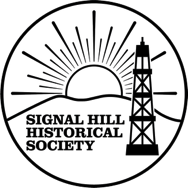How Signal Hill Got Its Name and Some Mysteries
Written by Claudine Burnett
Learn more at: http://claudineburnettbooks.com
What Name??
Most histories of Signal Hill report the name came about because early California Native Americans used the hilltop for signal fires. But all this was disputed back in 1941 when pioneer family members, Philip and Llewellyn Bixby voiced a different story.
They told reporter Walter Case (Sun 7/24/1941) they believed Signal Hill was so named because for many years ships at sea took their bearings from a large landmark tripod which stood atop the hill. Both Bixbys remembered the tripod, but it was so long ago they couldn’t remember about its placement. Case questioned sailors about this fact and they said it would have been entirely practicable to have established such a point atop Signal Hill where, with a glass, it could be seen from long distances in various directions.
Also noted was the fact that in early days the Hill was known as “Cerritos Hill.” In her book Adobe Days Sarah Bixby Smith mentioned that the Spaniards called the Hill “El Cerrito” (the Little Hill) and she expressed keen regret over the change of the name to Signal Hill.
My own research discovered another hill in Los Angeles (at the head of First Street) named “Signal Hill.” I also found that it wasn’t until 1892 that the term “Signal Hill” came to replace “Cerritos Hill” in the press. From 1890-1892 the two names were both used to describe the same location, after 1892 only “Signal Hill” was used. I haven’t been able to find anything else about the tripod on the Hill, but I did come across a story about a survey marker.
Survey Marker
Residential development of Signal Hill began in May 1905, but shortly before then E. P. Dewey, assistant city engineer, surveying residential lots near the top of Signal Hill was approached by an old man. The stranger asked his assistance in locating a monument he had placed on the summit 50 years earlier. The two men searched for the stone, but it took a few days to locate it, and only then it was discovered by accident. Engineer Dewey, at the summit of the hill, attempted to drive a stake into the ground and found the monument two inches below the surface. It was granite, 8 inches square and 18 inches long with a drill hole exactly in the center.
The old man introduced himself as John Rockwell, a visitor to the city. He told Dewey he had been a member of the United States Coast and Geodetic Survey crew whose mission was to plot latitude and longitude of prominent points in California after it became a state in 1848. The first few years they spent plotting points for light houses, but by 1853 they started to concentrate on other high points including the hill then known as "El Cerrito.”
At the summit, at an elevation of 364 feet, they planted one of their markers. They built a fence around the marker to keep out the horses and cattle that roamed everywhere. They also posted several handbills printed on cotton cloth written in both English and Spanish, telling the public the marker was the property of the United States and requesting that it not be disturbed. Evidently the fence and signs didn't work, since the ground around the marker was plowed many times. In 1905, however, the Signal Hill Improvement Company decided to set aside a 60 x 130 foot area on the summit as a public park. In the center of the trees and flowers rested the monument along with a tablet telling its history. Also included were the coordinates: Latitude 33 degrees, 48 minutes north; longitude, 118 degrees, 9 minutes, 46.7 seconds west from Greenwich; height above mean sea level, 365.64 feet (Evening Tribune 5/3/1905)
Mystery of the Spanish Armor & Buried Treasure
I came across two interesting stories I have been unable to substantiate in the book Southern California Treasures (1969) by Jesse Rascoe.
Rascoe states that Southern California papers reported an interesting find in 1937, saying in part, “A Spanish breast plate from an old suit of armor was found near Signal Hill two weeks ago. It was identified as belonging to the period of the 1770s and 1780s.” I did a thorough search through California and national newspapers and found no such story. Could it have been true?
In the days before flood control the area north of Signal Hill was marshy and known as “water lands.” It wasn’t an area early explorers would generally choose to visit unless they needed to survey the terrain and sea. In fact when Dana Burks and Henry Barbour obtained an option on land in the west part of Long Beach in 1905 they considered dredging the existing slough around Signal Hill to Alamitos Bay. Long Beach would have become an island. Instead Burks and Barbour decided to build a harbor. It would have been lovely if Rascoe had included a bibliography or footnote in his book to trace the story, but he did give a citation to another.
In the Association Newsletter, Oscoda, Michigan, January 1969 issue, Rascoe received this report: “K/B reports that her son-in-law found a dandy catch of silver and gold coins with his detector on Signal Hill near Long Beach, California. K/B lives in Colorado and her son-in-law lives in California.”
Again, a search through local and national newspapers, did not report the story. I’m sure it’s a story the local press would not have overlooked. So....did Spanish explorers once visit the Hill and did they, or someone else, leave behind a catch of valuable coins? Well, Signal Hill would have been relatively hard to get to in earlier times, but that in itself might have made it a recognizable and relatively safe place to leave behind armor and treasure. What do you think?

